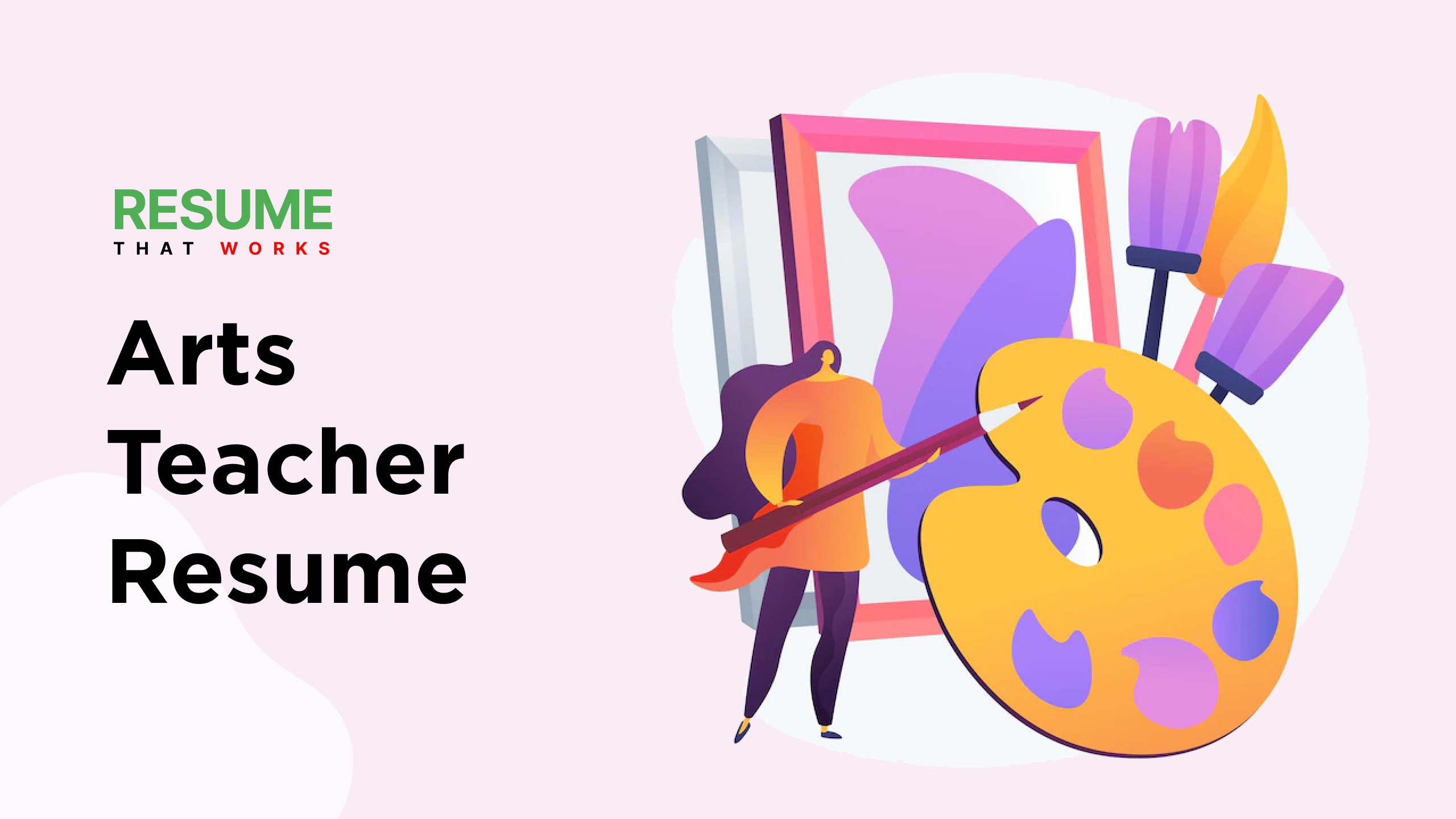The debate about the subjectivity of art and its objective pursuit of portraying human emotions has become a thing of the past. Now, art is defining the eras with its ubiquitous characters and taking center stage at the unlikeliest places.
Arts teachers are in high demand in schools and colleges because the mediums of artistic expression have expanded vastly. If we take into account the school and college system, more students are willing to pursue arts because they not only find it a medium for themselves but also as a lucrative mode of earning bread.
In this blog, we will give a bird’s eye view of the position of art teacher, the need to have an artistic or stand-out resume, and then a detailed guide on how to develop one.
Overview Of The Position
When we take into account the mechanics and dynamics of the art teacher position, we can safely say that the main duty of the teacher is to instill a spirit of art and creativity in students. When this is already done, they help students define and hone their skills based on their inclinations, including political, social, economic, and other backdrops.
These are not easy tasks, from infusing an ambition for art and then helping them express that through different modes. However, there are certain roles and responsibilities that art teachers are entrusted with that help them plan and execute this end. Here is a look at those tasks:
- Planning, development, and execution of art curriculum and art history
- Purchasing of art supplies and inventory
- Arranging art materials for students in the classroom
- Delivering lectures and giving demonstrations on art techniques
- Discussing various approaches toward artistic expression
- Organizing internal and external exhibitions to recognize the work done by students
- Assisting administration with the development of learning programs
To be able to do all these and many more tasks, as the needs arise, teachers need to have certain skills that can help them wade through tricky waters. Take a look at these skills and see how many you possess and to what extent.
- Artistic Skills
- Empathetic Skills
- Interpersonal Skills
- Excellent Communication Skills
While writing your art teacher resume, you can incorporate these skills in yours to showcase to the recruiters that you are indeed capable of taking on the tasks of teaching arts to students.
Why Writing A Stand Out Resume Is Important
As art teachers, professionals do not only have to show artistic brilliance and creative prowess but also administrative, social, and strategic capabilities. It may seem tempting to send a web link to your portfolio to the hiring committee of a school, but they are looking for more than just a person who can draw and paint. Teaching students is a big responsibility and they are always looking for a well-rounded person – someone who is responsible, talented, and a good administrator.
To show a hiring manager that you are indeed the kind of candidate that they are looking for, it is necessary to have a stand-out resume. It starts with contact information and goes through different sections including experience and qualifications to the additional skills section. It is the job of the aspiring art teacher to make a case for himself through these sections.
The Guide On Arts Teacher Resume Writing
Now that we have understood the importance of the role through its responsibilities and the ideal skills and qualities that recruiters look for in a candidate, it is time to take the next step. This section is about writing an art teacher’s resume through a detailed guide. Keep in mind that writing a resume is about being creative and technical at the same time. In this spirit, let us go through each of the major milestones of the process one by one.
-
Formatting & Structure
Formatting and structure are something that pops out the moment someone takes a look at the resume. It is about the symmetry in which information is presented on the paper. The most common contributors to these are the overall style of writing the resume, margins, and fonts. The former deals with the way an art teacher would want to present his credentials, either through simple text or infographics. The margins are standard in the industry with one-inch measurements both vertically and horizontally. As for the font size and style, the most legible ones are the best ones.
As an art teacher, it is your judgment to pick the right type of bunch and make it work in your favor.
-
Header With Contact Information
This is the first thing that can catch the reader’s eye when they start going through a resume. Since it is at the top and most likely written in bold fonts, it is best to be straightforward and to the point with the header. The header contains the contact information of the professional so that recruiters can connect with him. The most important things in the header are full name, email and phone number, and address if the role is area specific.
-
Job/ Objectives Summary
A job or objectives summary is the gist of the career and a hint at the professional aspirations. It is a short paragraph, no more than two to three sentences that cover the qualifications, experience, and plans of the art teacher. The execution for the two is different as the job summary is written by those who have some experience whereas the summary of the objectives is written by aspiring art teachers with not enough experience. In any case, it should be written with great care and attention because recruiters often rely on it for initial screening.
-
Work Experience
This section is self-explanatory in what it is but there are certain pitfalls and best practices that candidates should follow. First of all, there is no need to add irrelevant work experience that offers no value to the role the professionals are applying for. As for those that do, the best way to write them is by starting with the job title or designation, time of service, and then listing the responsibilities and achievements. This is important because merely telling them the role is not impressive at all.
-
Academic Qualifications
For an art teacher, academic qualifications are important to showcase and highlight in the resume. These days, schools prefer individuals with a background in formal training and teaching. The most common qualifications in this field are bachelor’s and masters in fine arts, with an emphasis on art education and training is a good start. To write these details, start with the degree title, then the school name, the time of attending the end listing of major courses and interests.
-
Portfolio
Showcasing a portfolio is an important step in the resume writing of an art teacher. But there is no way professionals can rest assured that it will be seen if they only leave a link to the online resource. The best way to make sure that it will not be missed by the recruiters is to integrate some items in the resume. It can be a watermark, an element at the beginning or the end, or anything artistic. Of course, you should leave a dedicated link to the portfolio but it is necessary to give them a taste so they come back asking for more.
-
Special Skills
Many experts believe that the special skills section is redundant but we do not agree. Certain things contribute to a professional’s journey but cannot be documented through typical sections. It can be a proficiency in another language, a mastery at wielding a tool that can make a professional stand out from the rest of the candidates in the race. Still, art teachers should ensure that they are providing true and to-the-point information.
Complementing Arts Teacher Resume With A Cover Letter
These days, more than merely writing and sending a resume is required. Recruiters want more from aspirants so that they can learn more about them and connect with them at a higher level. Since resumes have their merits and limitations, a cover letter can come to the fore. It is a document that describes the history, qualifications, and aspirations of an art teacher. By providing a well-written resume, professionals can ensure that their case will be strong, even when they did not ask specifically for one. The best way to write a cover letter is to juxtapose it with the resume so that both augment and complement each other. If you are not up for the task to write a cover letter or a resume, get a professional resume writer and let him do the heavy lifting for you.
FAQ
What should I put on my art teacher’s resume?
The art teacher’s resume is not different than any other profession’s. The best way to make a case for your candidature is by showcasing your skills and strengths impressively. We have shared a detailed guide on how to write a resume in this blog that will help aspiring teachers compose riveting and compelling resumes.
What is the role of the art teacher?
The role of the art teacher is composed of many traits. It is not enough to be just good at painting and drawing. The ideal candidate has a mixture of skills and traits including administrative, planning, teaching, and training capabilities.
What are the qualities of an art teacher?
The most sought-after qualities in an art teacher are as follows:
- People person
- Excellent communicator
- Empathetic and social
- Good at drawing and demonstrating skills
- Nurturing art inclinations in students
What type of resume is best for teachers?
When it comes to resume writing for art teachers, it is best to go with more artistic themes. Instead of simply relying on descriptions and typical sections, aspirants can design their resumes using colors and shapes. This way, they not only convey important information but also showcase their artistic capabilities.
How do I describe my art skills on a resume?
It is often hard for professionals to showcase their skills on a piece of paper. Still, some methods can help them paint a true picture for the recruiters. The most common one includes using infographics and shapes. Through these, you cannot only show them what you know but also how much you know through stars and points.




